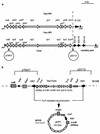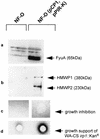Transfer of the core region genes of the Yersinia enterocolitica WA-C serotype O:8 high-pathogenicity island to Y. enterocolitica MRS40, a strain with low levels of pathogenicity, confers a yersiniabactin biosynthesis phenotype and enhanced mouse virulence
- PMID: 11895945
- PMCID: PMC127873
- DOI: 10.1128/IAI.70.4.1832-1841.2002
Transfer of the core region genes of the Yersinia enterocolitica WA-C serotype O:8 high-pathogenicity island to Y. enterocolitica MRS40, a strain with low levels of pathogenicity, confers a yersiniabactin biosynthesis phenotype and enhanced mouse virulence
Abstract
The high-pathogenicity island (HPI) of yersiniae encodes an iron uptake system represented by its siderophore yersiniabactin (Ybt). The HPI is present in yersiniae with high levels of pathogenicity--i.e., Yersinia pestis, Y. pseudotuberculosis, and Y. enterocolitica biogroup (BG) 1B--but absent in Y. enterocolitica strains with low (BG 2 to 5) and no (BG 1A) levels of pathogenicity and has been shown to be an important virulence factor. Comparison of the HPI in Y. enterocolitica (Yen-HPI) and that in Y. pestis and Y. pseudotuberculosis revealed that, in contrast to genes of the variable region, genes of the core region (genes irp9 to fyuA) are highly homologous. In the present work the Yen-HPI core genes were rescued from the chromosome of Y. enterocolitica WA-C (BG 1B, serotype O:8) using the FRT-FLP recombinase system. Transfer of the resulting plasmid pCP1 into the siderophore-deficient strain Y. enterocolitica NF-O (BG 1A) led to no halo on siderophore indicator chrome azurol S (CAS) agar. Transfer of pCP1 into the Y. enterocolitica strain MRS40 (serotype O:9, BG 2; phenotype, CAS negative) led to a CAS halo larger than that of parental strain WA-C, indicating high Ybt production. pCP1 was highly unstable in iron-deficient medium, and no enhanced mouse virulence conferred by MRS40 carrying pCP1 could be detected. To overcome the problem of instability, pCP1 was integrated into the chromosome of MRS40, leading to the formation of a CAS halo comparable to that seen with WA-C and correspondingly to increased mouse virulence. Thus, the core genes of Yen-HPI are sufficient to confer a positive CAS phenotype and mouse virulence to Y. enterocolitica MRS40, BG 2, but are insufficient to confer this phenotype to Y. enterocolitica NF-O, BG 1A.
Figures





References
-
- Autenrieth, I. B., R. Reissbrodt, E. Saken, R. Berner, U. Vogel, W. Rabsch, and J. Heesemann. 1994. Desferrioxamine-promoted virulence of Yersinia enterocolitica in mice depends on both desferrioxamine type and mouse strain. Infect. Immun. 169:562-567. - PubMed
-
- Brem, D., C. Pelludat, A. Rakin, C. A. Jacobi, and J. Heesemann. 2001. Functional analysis of yersiniabactin transport genes of Yersinia enterocolitica. Microbiology 147:1115-1127. - PubMed
-
- Carniel, E., A. Guiyoule, I. Guilvout, and O. Mercereau Puijalon. 1992. Molecular cloning, iron-regulation and mutagenesis of the irp2 gene encoding HMWP2, a protein specific for the highly pathogenic Yersinia. Mol. Microbiol. 6:379-388. - PubMed
Publication types
MeSH terms
Substances
LinkOut - more resources
Full Text Sources
Other Literature Sources

